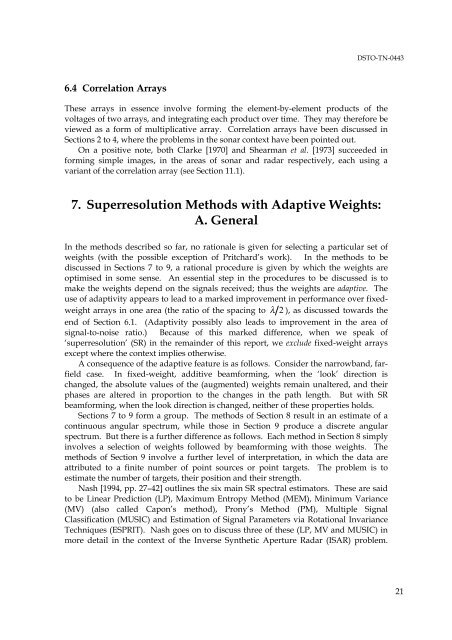Suitability of Correlation Arrays and Superresolution for Minehunting ...
Suitability of Correlation Arrays and Superresolution for Minehunting ...
Suitability of Correlation Arrays and Superresolution for Minehunting ...
Create successful ePaper yourself
Turn your PDF publications into a flip-book with our unique Google optimized e-Paper software.
DSTO-TN-0443<br />
6.4 <strong>Correlation</strong> <strong>Arrays</strong><br />
These arrays in essence involve <strong>for</strong>ming the element-by-element products <strong>of</strong> the<br />
voltages <strong>of</strong> two arrays, <strong>and</strong> integrating each product over time. They may there<strong>for</strong>e be<br />
viewed as a <strong>for</strong>m <strong>of</strong> multiplicative array. <strong>Correlation</strong> arrays have been discussed in<br />
Sections 2 to 4, where the problems in the sonar context have been pointed out.<br />
On a positive note, both Clarke [1970] <strong>and</strong> Shearman et al. [1973] succeeded in<br />
<strong>for</strong>ming simple images, in the areas <strong>of</strong> sonar <strong>and</strong> radar respectively, each using a<br />
variant <strong>of</strong> the correlation array (see Section 11.1).<br />
7. <strong>Superresolution</strong> Methods with Adaptive Weights:<br />
A. General<br />
In the methods described so far, no rationale is given <strong>for</strong> selecting a particular set <strong>of</strong><br />
weights (with the possible exception <strong>of</strong> Pritchard’s work). In the methods to be<br />
discussed in Sections 7 to 9, a rational procedure is given by which the weights are<br />
optimised in some sense. An essential step in the procedures to be discussed is to<br />
make the weights depend on the signals received; thus the weights are adaptive. The<br />
use <strong>of</strong> adaptivity appears to lead to a marked improvement in per<strong>for</strong>mance over fixedweight<br />
arrays in one area (the ratio <strong>of</strong> the spacing to λ 2 ), as discussed towards the<br />
end <strong>of</strong> Section 6.1. (Adaptivity possibly also leads to improvement in the area <strong>of</strong><br />
signal-to-noise ratio.) Because <strong>of</strong> this marked difference, when we speak <strong>of</strong><br />
‘superresolution’ (SR) in the remainder <strong>of</strong> this report, we exclude fixed-weight arrays<br />
except where the context implies otherwise.<br />
A consequence <strong>of</strong> the adaptive feature is as follows. Consider the narrowb<strong>and</strong>, farfield<br />
case. In fixed-weight, additive beam<strong>for</strong>ming, when the ‘look’ direction is<br />
changed, the absolute values <strong>of</strong> the (augmented) weights remain unaltered, <strong>and</strong> their<br />
phases are altered in proportion to the changes in the path length. But with SR<br />
beam<strong>for</strong>ming, when the look direction is changed, neither <strong>of</strong> these properties holds.<br />
Sections 7 to 9 <strong>for</strong>m a group. The methods <strong>of</strong> Section 8 result in an estimate <strong>of</strong> a<br />
continuous angular spectrum, while those in Section 9 produce a discrete angular<br />
spectrum. But there is a further difference as follows. Each method in Section 8 simply<br />
involves a selection <strong>of</strong> weights followed by beam<strong>for</strong>ming with those weights. The<br />
methods <strong>of</strong> Section 9 involve a further level <strong>of</strong> interpretation, in which the data are<br />
attributed to a finite number <strong>of</strong> point sources or point targets. The problem is to<br />
estimate the number <strong>of</strong> targets, their position <strong>and</strong> their strength.<br />
Nash [1994, pp. 27–42] outlines the six main SR spectral estimators. These are said<br />
to be Linear Prediction (LP), Maximum Entropy Method (MEM), Minimum Variance<br />
(MV) (also called Capon’s method), Prony’s Method (PM), Multiple Signal<br />
Classification (MUSIC) <strong>and</strong> Estimation <strong>of</strong> Signal Parameters via Rotational Invariance<br />
Techniques (ESPRIT). Nash goes on to discuss three <strong>of</strong> these (LP, MV <strong>and</strong> MUSIC) in<br />
more detail in the context <strong>of</strong> the Inverse Synthetic Aperture Radar (ISAR) problem.<br />
21

















